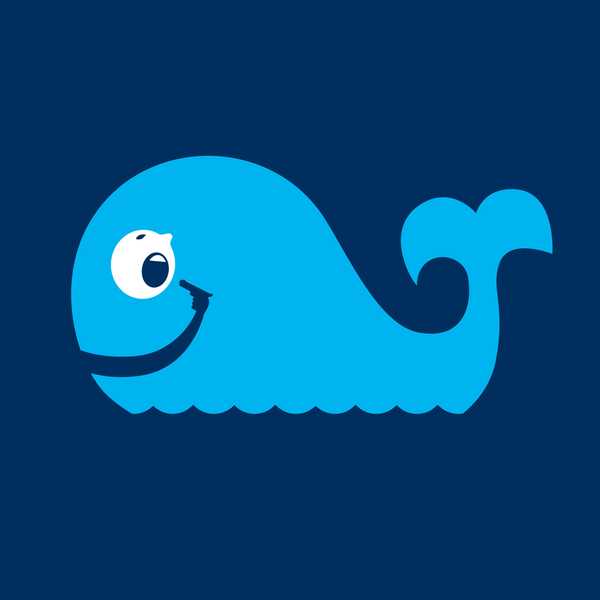
Internet Hoax Hysteria: What's the Truth?
Story by Sandra Song / Illustration by Noma Bar
Jul 22, 2019
With her bulging eyes and Joker-esque smile, Momo may have briefly been every parent's worst nightmare. A sculpture originally created in 2016 by Japanese special effects artist Keisuke Aiso, she sparked international panic earlier this year when alleged reports of a deadly online challenge in her name began to spread. According to Internet lore, Momo was a supernatural figure who used chat apps like WhatsApp to goad young children into performing dangerous self-harm tasks and even, it was rumored, spurred the suicide of a 12-year-old Argentinian girl. And though Internet culture experts and journalists have since deemed the challenge nothing more than a hoax, international coverage and subsequent backlash related to it led Aiso to speak out about the phenomenon and reveal that he'd disposed of Momo last fall. "Children can be reassured Momo is dead," Aiso told UK tabloid The Sun. But before he revealed her demise, his creation had launched a larger conversation about the myth-making surrounding extreme Internet challenges and their actual impact.
While there have been numerous media reports of young kids being targeted by extreme Internet challenges like Momo that supposedly led to self-harm and even suicide, the veracity of many of these accounts is shaky at best. Which leads us to ask, why exactly was the world so quick to fall for a story based in urban lore and the Creepypasta community? Especially when there was so little proof of actual harm to begin with?
As Brad Kim, editor in chief of the Internet's exhaustive meme encyclopedia, Know Your Meme, explains, "A lot of [panic] was facilitated by less-than-factually-accurate and disproportionate [coverage of these challenges] at the local news media level," adding that these smaller outlets tend to hop on these stories very quickly, especially when concerned parents bring them up. "That's one specific pattern that's really stuck out."
Kim observes that Internet-bred "challenges" seemed to pick up steam as early as 2011, with 2012 serving as "the breaking point in terms of both the number of challenges and the spawning of different ones." These challenges, which often went viral on YouTube or 4Chan, included everything from the Cinnamon Challenge (which encouraged kids to put a spoonful of ground cinnamon into their mouths) to The Knife Song (a revival, sparked by a song, of a decades-old game where you stab a knife in between your spread fingers in a pattern) to the Condom Challenge (in which you snort a condom and pull it out through your mouth). Even more insidiously, the Cutting for Bieber Challenge supposedly led Justin Bieber fans to cut themselves in an attempt to get the star to stop smoking weed, and the Blue Whale Challenge allegedly led to a rash of suicides.
Thought to have originated on the Russian social media site VK, Blue Whale supposedly challenged young children to follow 50 different steps assigned to them by an administrator. The challenge started with benign requests like "draw a picture," but the tasks became progressively dangerous (like carving a whale into your arm) over the following days, culminating in the final task — committing suicide — on the last day. The Blue Whale Challenge started appearing in international headlines in 2016 after a claim that over 130 Russian children had died from it appeared in a Russian paper called Novaya Gazeta. Panic spurred by the game eventually led to the alleged arrest of one of the game's supposed "administrators." That said, there's murkiness surrounding whether this challenge was real in the first place, and a Snopes report has labeled the claim about the 130 deaths "unproven." BuzzFeed News senior reporter Katie Notopoulos — who's covered Internet culture for the past seven years — has her own doubts about the Blue Whale Challenge itself as well as the existence of this supposed administrator and his subsequent arrest. However, the fact that "we can't be 100 percent sure" that its existence is absolutely fake is part of what makes it messy, she says.
Unfortunately, these alarmist news reports based on unverified interviews tend to breed even more copycats who allege that they've "lived" through these challenges, especially on smaller blogs that claim to have spoken to survivors of these games and/or their family members. Take the story of a 22-year-old Indian man, known only by the name Alexander, whose story about how he "was about to carve the blue whale motif on his hand when the police team barged into his house on time and saved his life" has been picked up by numerous Indian blogs, with some even making it to reputable news outlets like The Times of India. Or alleged interviews with the father of a 12-year-old in Tunisia who was speculated to have died by suicide due to Blue Whale. Or the fact that the only member of a Momo-centric Facebook group who was willing to speak about attempting the challenge was a Filipino woman who refused a video chat interview to verify her identity. For Western media picking up these stories — like the British tabloids, which have been some of the most vociferous chroniclers of these sagas — the one common denominator between many of these alleged victims is that they all hail from remote regions of foreign countries. Notopoulos theorizes that one reason why these stories are so frequently peddled by tabloids is because, thanks to these geographical and linguistic barriers, they're difficult to prove or, in this case, disprove.
"Sometimes, having these rumors be from a remote region in another country is a good way of stopping anyone from actually fact-checking them," she explains. "It's difficult to track down people in other countries, and making it seem like the origin is far away is a good way to get a rumor to spread."
Notopoulos believes that this uncertainty, combined with the aforementioned pick-up of these stories by local news outlets, leads to the challenges becoming self-fulfilling prophecies.
"Once it's out in the world, people are actually going to try and sort of make it real," she says, before adding, "For a lot of local news, it's easier to just say, 'Hey parents, we're giving you a warning [but] we can't verify this.'"
Given this, it should come as no surprise that things get more complicated when concerned parents themselves begin filling in the blanks and bring the story — presumptions and all — to the media. For example, after a 15-year-old boy named Isaiah Gonzalez died in the summer of 2017, his family told his local USA Today affiliate that they found "proof" on the phone that he was participating in the Blue Whale Challenge and that his suicide was allegedly live-streamed.
"It could happen to any family. We're just urging parents, look at your kid's social media," his father told the outlet. "I think to him, it was a joke. It wasn't him trying to commit suicide. I don't see him doing that."
But as Notopoulos' colleague Jane Lytvynenko — a BuzzFeed News reporter who's reported extensively on online hoaxes and fake news — sees it, "This type of moral panic over what our children are doing really predates the Internet." After all, one can draw parallels between the Internet's current positioning as a boogeyman amongst concerned parents and moral panics from earlier decades such as Satanic Panic and allegations that bands like the Beatles hid secret messages on their records. The difference is that the Internet has allowed these types of moral panics to spread much faster, on an international scale.
Dr. Joan Donovan, director of the Technology and Social Change Research Project at Harvard's Shorenstein Center, agrees with Lytvynenko that this demonization of teen fads can to some extent be considered a successor to the type of paranoia that haunted parents during the sweeping social changes of the 1960s. However, instead of sex, drinking and drugs, the new fear du jour is all of the things that take place when their unsupervised kids live their lives online. In some cases, it's a justified fear. Though Donovan believes parents are currently more concerned about their kids "wasting time" on the Internet rather than getting sucked into the Momo challenge, she adds that, "Sadly, not all people are good people."
Donovan also points out that overdramatized documentary series like Investigation Discovery channel's Web of Lies have fed upon parents' generalized anxiety when it comes to the Internet — something that's likely led to an increased use of "net-nanny style apps and software, [which] are also indicative that parents seek more awareness of their children's whereabouts online." Again, we're forced to reckon with the impact of sensationalized media, as well as the publication of these (mostly unverified) reports, which has time and time again led to a muddying of the story that makes it harder to differentiate what is reported fact and what are aspects of the larger hoax.
"Even though most parents [themselves] have been using the Internet for a long time, there's still this latent fear of, 'Oh, the Internet is a weird, scary place where anything could happen,'" Notopoulos says.
And, unfortunately, one of those things that can happen is adult and teenaged clout-chasers playing into the perpetuation of these hoaxes by recording and posting videos of themselves pretending to attempt these "challenges." In these bids for attention, clicks and subscribers, the result is further amplification of the challenge in question and a continued flurry of videos from Internet-savvy participants (namely teens) "who are fully aware of this media cycle practice" and take advantage of these fears in order to game the media, per Know Your Meme's Brad Kim.
Kim points toward the Tide Pod challenge as an example of this phenomenon. Soon after Procter & Gamble introduced these pods in 2012, there were reports of young kids mistaking the brightly colored packets of laundry detergent for candy and consuming them. Subsequently, Internet forums — which, Kim notes, are dominated by in-the-know youth — latched onto the reports, and hoax-making ensued when teen "edgelords" began posting videos of themselves pretending to ingest the pods, a phenomenon that was picked up extensively by local news media. In the process, a relatively small number of copycat teens who watched these videos did actually attempt the challenge, leading to illness and trips to the hospital. By early 2018, what started as a real — albeit small and unintentional — phenomenon of young children accidentally eating the pods had turned into a full-blown (yet mostly fake) viral Internet challenge. "They basically wanted to achieve the effect of Tide issuing a warning to not eat them," Kim explains, before adding that the goal was mainly just to make funny videos. "That was the endgame of the hoax."
It was claimed that over 130 Russian children had died from the Blue Whale Challenge
And teens trolling adults by pretending to engage in harmful challenges are "just getting more and more elaborate now, because the spread is getting way more multimedia-oriented," Kim says. That said, when something like Momo or the Blue Whale challenge enters mainstream consciousness, oftentimes it's difficult for less Internet-savvy people to distinguish what's real and what's fake, especially when more adept users are deliberately using image manipulation and tech fake-outs.
"I've seen some people even go as far as faking bodily harm like scratches and showing blood," says paranormal investigator Alex Bobulinski, who runs a popular YouTube channel called Spectral Wolfpack Paranormal in which he investigates urban legends and rituals. "They do it for shits and giggles, and I think those people just probably don't have the best morals. They're purposely trying to scare people."
Bobulinski — who posted a video of himself disproving the Momo challenge back in July 2018 — also points out that in this day and age, it's very easy for people to fake stuff via special effects, coding and special apps.
While kids may not be actually dying from these extreme challenges, Kim says it's hard to curb panic amongst parents once these adult forums and exploitative videos begin to spread and make headlines. Unfortunately, he adds, once a hoax reaches this level, it's also very difficult to reverse the damage that's been done, especially when people online continue to gleefully add fuel to the flames — something that, scarily enough, has the potential to morph things like Momo and Blue Whale into self-fulfilling prophecies via mass hysteria.
But perhaps the Internet's role as a faceless, ever-present boogeyman also has something to do with the rise of Internet lore usurping reported fact, especially when it comes to explaining some of the most difficult-to-process tragedies. After all, as Notopoulos points out, it seems plausible that these types of conversations become more prevalent as serious topics like mental health and suicide are introduced into the equation.
"In a way, it's a convenient fiction that explains something so unfathomable," she continues, before alluding to the fact that youth mental illness is a larger problem that may be more difficult to deal with due to broader societal stigma. "I do think a lot of people are so afraid... that coming up with the idea that the Internet 'tricked them' into [committing suicide or self-harm] seems more reasonable than the reality that it's all kind of unknowable and complex."
Illustration: Noma Bar
MORE ON PAPER
Music
You Don’t Move Cardi B
Story by Erica Campbell / Photography by Jora Frantzis / Styling by Kollin Carter/ Hair by Tokyo Stylez/ Makeup by Erika LaPearl/ Nails by Coca Nguyen/ Set design by Allegra Peyton
Story by Erica Campbell / Photography by Jora Frantzis / Styling by Kollin Carter/ Hair by Tokyo Stylez/ Makeup by Erika LaPearl/ Nails by Coca Nguyen/ Set design by Allegra Peyton
14 October
Entertainment
Matthew McConaughey Found His Rhythm
Story by Joan Summers / Photography by Greg Swales / Styling by Angelina Cantu / Grooming by Kara Yoshimoto Bua
Story by Joan Summers / Photography by Greg Swales / Styling by Angelina Cantu / Grooming by Kara Yoshimoto Bua
30 September
Music
Demi Lovato Is No Joke
Story by Ivan Guzman / Photography by Jason Renaud / Styling by Chris Horan/ Makeup by Loftjet / Set design by Allegra Peyton
Story by Ivan Guzman / Photography by Jason Renaud / Styling by Chris Horan/ Makeup by Loftjet / Set design by Allegra Peyton
15 September
Music
Role Model Isn’t In Kansas Anymore
Story by Tobias Hess / Photography by Richie Talboy / Styling by Angelina Cantú / Grooming by Jerrod Roberts / Set design by Allegra Peyton
Story by Tobias Hess / Photography by Richie Talboy / Styling by Angelina Cantú / Grooming by Jerrod Roberts / Set design by Allegra Peyton
14 August
Internet
Quen Blackwell Takes Over
Story by Ivan Guzman / Photography by Richie Talboy / Styling by Angelina Cantú / Makeup by Kimora Mulan / Hair by Malcolm Marquez / Nails by Kimmie Kyees / Set design by Allegra Peyton
Story by Ivan Guzman / Photography by Richie Talboy / Styling by Angelina Cantú / Makeup by Kimora Mulan / Hair by Malcolm Marquez / Nails by Kimmie Kyees / Set design by Allegra Peyton
11 August




